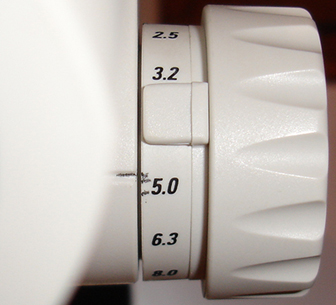
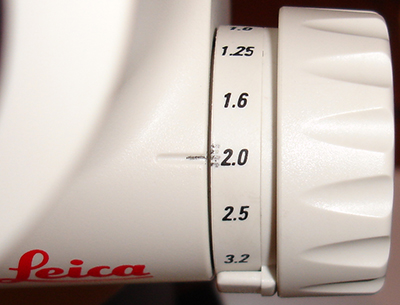
|
Topical tip: Taking accurate and repeatable measurements with a continuously variable zoom stereo microscope |
Taking measurements of subjects under the microscope is routine for the hobbyist and various approaches can be adopted depending on whether visual and/or imaging work is being carried out and personal preference. Two common approaches are to calibrate an eyepiece reticule for each objective or to calibrate part or whole of the field width of a camera image and take measurements in software. On the compound or stereo microscope with fixed mag objectives, the calibration of each objective can be a one-off as the mags remain fixed as long as other parameters such as adaptors, camera projection length, eyepieces, Optovar etc are kept the same as those for the calibration.
For stereo microscopes with a continuously variable zoom, another parameter needs careful control if relying on a one-off calibration, i.e. the repeatable resetting of the mag zoom to that used for the calibration. Depending on the microscope's design, precise resetting may not be guaranteed unless the user takes action to ensure it.
For my own Leica S8 stereo with 1 - 8X zoom optics shown in close-up below, the mag marker is a broad plastic notch and there are no fine markings on the mag changer or click stops at the marked settings. If casually setting the mag at a labelled point, e.g. 2X or 5X, there are a short range of positions where the mark could be regarded as roughly lined up. This problem won't arise if the stereo uses paired objectives for each mag or if the mags are changed between fixed settings e.g. using a rotating drum with Galilean optics. On older stereos with a continuous zoom there may also be the possibility of slight hysteresis if component wear, i.e. repeating an exact mag setting may not always give the same internal optics setting.


Above: The mag changer on a Leica S8 1 - 8x zoom stereo, showing the broad setting mark on body. The pencil marks were added in mag marker and on mag changer to explore the variation in measurements over a narrow range. The current setting shown at 5X and the upper mark on the 2X is for where an eyepiece reticule divisions exactly matched those of a micrometer slide for ease of visual measurements, i.e. at the 5X setting 1 eyepiece reticule division was equivalent to 0.05 mm.
If studying many biological subjects under the stereo, a high degree of accuracy and repeatable measurements may not be needed e.g. whether a feature on an insect is 1.0 or 1.2 mm (20% variation) may not be important for identification given the potential for variability between individuals, maturity etc. of many organisms. But if carrying out a study where accurate measurement to say 1% is more important, a more rigorous procedure may be needed; this can be desirable for some manmade objects, perhaps electronics or important components. In my case, I was recently taking some accurate measurements of slide rule markings as part of a study of production methods/quality between different makers/models which prompted me to explore the best approach for accuracy and repeatability using a stereo.
To see how fine changes to the mag setting affected measurements, I took images with a Sony NEX 5N camera body on the stereo photo port of a 0.01 mm stage micrometer at the fine pencil marks above for the 2X and the 5X mag settings. In image software the pixel length across the micrometer image could be made. (In my case using the measurement tool in Adobe CS2; for many dedicated microscope cameras, measurement features are a feature of the bundled software. Freeware such as ImageJ can also be used.) The measurements between the two settings extremes varied by 4% at both 2X and 5X, equivalent to over 100 pixels variation on the images. This may be an unacceptable level of variation if accuracy and repeatability is important.
Ensuring repeatability and accuracy
On my stereo a few approaches were tried.
1) Adding fine marks to the mag changer and body, as shown above. The pencil marks were crude but did ensure high level of repeatability. Although to routinely use this approach I would use more wear-proof finer marks.
2) For each sequence of measurements taken at a given mag, always take an image of a micrometer slide to internally calibrate that set of images. As most of my stereo work is image driven, this is my preferred method if using the images for measurements as retains absolute certainty even if forgot to set accurately the 'calibration position' on the mag changer.
3) If taking measurements visually using an eyepiece reticule, for a given mag setting always calibrate the eyepiece with a slide micrometer. A zoom mag changer is a benefit for this approach as can finely adjust the zoom to match an easy to read off reticule value. This can work well but need to remember not to change mag setting during a sequence of measurements. This approach also allows the user to directly assess the sensitivity of zoom setting on calibration, by rocking the zoom changer at a given setting while looking at the reticule / micrometer slide through the eyepieces.
4) For certain suitable subjects, lay a fine 'rule' on the subject for direct measurements which are thus independent of the mag setting. This particularly suited the perfectly flat slide rules I was studying. One of the common styles of modern eyepiece micrometer is typically and precisely ruled to 0.1 mm and can serve well as a rule if this level of accuracy is sufficient.
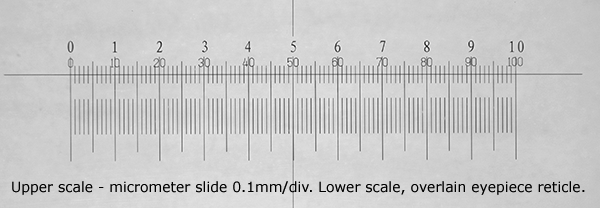
A 19 mm diameter eyepiece reticule overlain on a 3 x 1 inch micrometer slide to check that the reticule is accurately calibrated. The reticule can then serve as a rule for suitable subjects. The reticules cost typically £20 new from suppliers such as Knight Optical (UK). Micrometer slides typically cost £15.
For flat subjects, as in my case with the slide rules, for calibration/measurements and flatfield camera imagery, the subject can be presented at ca. 6° to the photo port or eyepiece with reticule so the subject is at right angles to the optical axis, as shown below. The affect on calibration is minor but has a marked affect on field flatness for photo work. Most affordable stereo models that the hobbyist is likely to own, use one of the angled eyepiece tube optical axes for the photo port; some models do use a vertical optical axis.
| Right: Leica S8 stereo with Sony NEX 5N on photo port. Ringlights and light guide are options for studies. The slide rule is angled exactly 6° to lefthand eyepiece tube which acts as photo port when selected. |
|
For flat subjects a monocular low power microscope / macroscope can be preferred as avoids the angled optics problem. Very high accuracy studies e.g. in engineering / electronics may require a dedicated measuring microscope which has features particularly suited for measurement such as micrometer actuated stages.
Different types of objects may require different approaches to measurement. The high accuracy single point to point measurement in an image for example may not be appropriate for subjects with noted roughness of features, as in the slide rule markings below, unless averages of multiple readings were taken. More appropriate was the reticule overlain on the rule, where the eye could effectively take the average, and where the accuracy of the reticule to ca 0.02 mm was good enough.
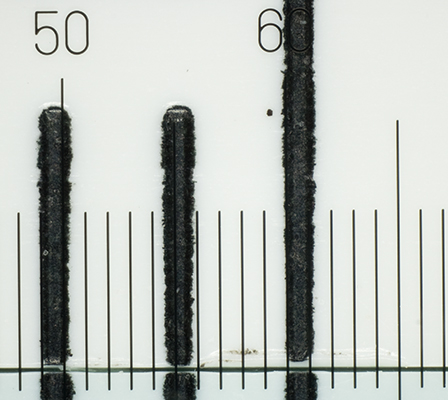
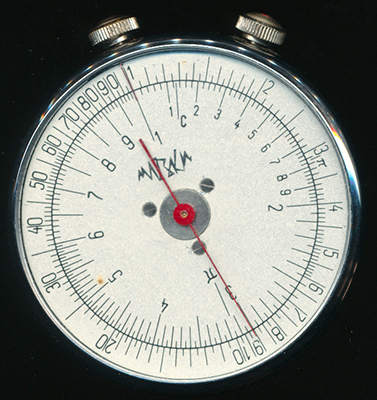
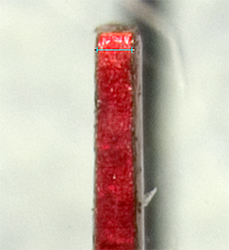 Left above: An eyepiece reticule (0.1 mm divisions) overlain on a Hemmi P280 slide rule, optical mag 20X, the roughness of the inked engravings makes a reticule more suited for this type of measurement than point to point. The reticle engravings touch a flat subject so there's no parallax error in readings.
Left above: An eyepiece reticule (0.1 mm divisions) overlain on a Hemmi P280 slide rule, optical mag 20X, the roughness of the inked engravings makes a reticule more suited for this type of measurement than point to point. The reticle engravings touch a flat subject so there's no parallax error in readings.
Right above: A Russian Matsku KL-1 pocket watch type slide rule. A microscope allows focussing through the glass face to measure features; a reticule cannot be overlain on this type of subject. Point to point measurements were also more suited to this type of well engineered feature.
Right: Detail of the fine metal pointer 0.1 mm wide, optical mag 20X, small crop of image. The blue line is the measurement tool in Adobe CS2 giving a pixel length of the feature. The optical mag of the stereo can be chosen to give a good pixel length to measure, albeit at the expense of decreased depth of field.
Comments to the author are welcomed.
Related article:
Micscape Lite December 2012: The Appeal of Slide Rules - For Use and as Collectables.
Published in the April 2013 edition of Micscape.
Please report any Web problems or offer general comments to the Micscape Editor .
Micscape is the on-line monthly magazine of the Microscopy UK web site at Microscopy-UK
©
Onview.net Ltd, Microscopy-UK, and all contributors 1995
onwards. All rights reserved.
Main site is at
www.microscopy-uk.org.uk.